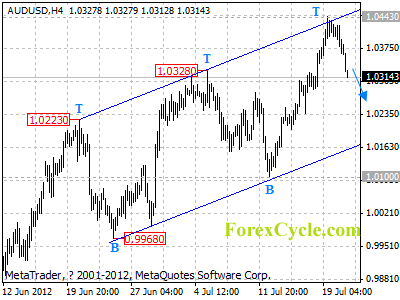By TraderVox.com
 Tradervox.com (Dublin) – The euro has continued to decline against the Japanese currency for the fourth week in a row. It closed the week at 12-year low after concerns the region’s debt crisis is worsening increased the demand for safety as the market went into the weekend. Most traders went for the yen, as the demand for the US dollar was dampened by bets on Federal Reserve’s action to stimulate economic growth in the country. The greenback remained unattractive to investors prior to release of data this week expected to show a slowdown in US growth. The Australian dollar closed the week on a high as implied volatility fell to five-year low allowing traders to buy riskier assets. The 17-nation currency dropped despite the approval by European officials on Spanish banks’ loan.
Tradervox.com (Dublin) – The euro has continued to decline against the Japanese currency for the fourth week in a row. It closed the week at 12-year low after concerns the region’s debt crisis is worsening increased the demand for safety as the market went into the weekend. Most traders went for the yen, as the demand for the US dollar was dampened by bets on Federal Reserve’s action to stimulate economic growth in the country. The greenback remained unattractive to investors prior to release of data this week expected to show a slowdown in US growth. The Australian dollar closed the week on a high as implied volatility fell to five-year low allowing traders to buy riskier assets. The 17-nation currency dropped despite the approval by European officials on Spanish banks’ loan.
According to Joe Manimbo who is a market analys at Western Union Business Solutions in Washington indicated that there is increased uncertainty in the market which has led to investors running away from the euro. He also added that there is a general hope for additional stimulus from major central banks around the world hence the continued demand for riskier assets.
The 17-nation currency dropped to the lowest levels since 2008 against the pound and dropped to new lows against the Australian dollar. The Spanish borrowing cost also increased to euro-era high which has added to speculations of adverse times ahead for the region. The euro zone currency dropped by 1.6 percent against the yen to trade at 95.43 yen on Friday in New York to record a weekly drop for the fourth week in a row. The euro had touched its lowest since November 2000 of 95.35 yen earlier in the day. The euro also continued to drop for the third week against the greenback, registering a 0.8 percent drop to trade at $1.2157, it also touched its June 2010 low of $1.2144 during trading on Friday.
Disclaimer
Tradervox.com is not giving advice nor is qualified or licensed to provide financial advice. You must seek guidance from your personal advisors before acting on this information. While we try to ensure that all of the information provided on this website is kept up-to-date and accurate we accept no responsibility for any use made of the information provided. Opinions expressed at Tradervox.com are those of the individual authors and do not necessarily represent the opinion of Tradervox.com or its management.
Article provided by TraderVox.com
Tradervox.com is a Forex News Portal that provides real-time news and analysis relating to the Currency Markets.
News and analysis are produced throughout the day by our in-house staff.
Follow us on twitter: www.twitter.com/tradervox
 Tradervox.com (Dublin) – The USD has been down against major currencies but remained strong against the euro. However, the Euro has touched new lows against most majors reaching a 12-year low against the yen as new market concerns rose on euro zone debt crisis. Here is the market outlook for major pairs.
Tradervox.com (Dublin) – The USD has been down against major currencies but remained strong against the euro. However, the Euro has touched new lows against most majors reaching a 12-year low against the yen as new market concerns rose on euro zone debt crisis. Here is the market outlook for major pairs.






